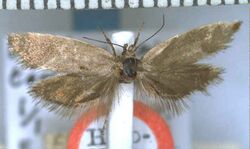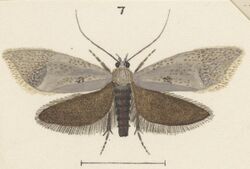Biology:Tingena tephrophanes
| Tingena tephrophanes | |
|---|---|

| |
| Female holotype | |
| Scientific classification | |
| Domain: | Eukaryota |
| Kingdom: | Animalia |
| Phylum: | Arthropoda |
| Class: | Insecta |
| Order: | Lepidoptera |
| Family: | Oecophoridae |
| Genus: | Tingena |
| Species: | T. tephrophanes
|
| Binomial name | |
| Tingena tephrophanes (Meyrick, 1929)[1]
| |
| Synonyms[2] | |
| |
Tingena tephrophanes is a species of moth in the family Oecophoridae.[2] It is endemic to New Zealand and has been found at Mount Arthur. Adults of this species are on the wing in January.
Taxonomy
This species was described by Edward Meyrick in 1929 using specimens collected by George Hudson in January in Flora Creek at Mount Arthur and named Borkhausenia tephrophanes.[3] In 1939 George Hudson discussed and illustrated this species under this same name.[4] In 1988 J. S. Dugdale placed this species in the genus Tingena.[2] The female holotype specimen is held at the Natural History Museum, London.[2]
Description
Meyrick first described this species as follows:
♀. 19 mm. Head, thorax grey. Palpi dark grey, slightly speckled white. Forewings rather elongate, costa gently arched, apex pointed, termen very obliquely rounded; glossy bluish-grey; extreme costal edge dark grey on basal ¼, then finely whitish to near apex; plical stigma rather elongate, blackish; a fine indistinct whitish inwards-oblique line from dorsum before tornus reaching half across wing, beyond this some obscure fuscous irroration crossing wing obliquely: cilia grey-whitish irrorated fuscous. Hindwings dark fuscous; cilia grey, darker within a faint slender whitish subbasal line.[3]
Similar in appearance to Tingena nycteris but can be distinguished as T. tephrophranes is a shiny leaden grey colour and has a tornal suffusion.[4]
Distribution
This species is endemic to New Zealand and has been found at Mount Arthur.[1]
Behaviour
The adult of this species is on the wing in January.[3]
Habitat
This species inhabits subalpine native forests.[4]
References
| Wikimedia Commons has media related to Tingena tephrophanes. |
Wikidata ☰ Q13861723 entry
 |


